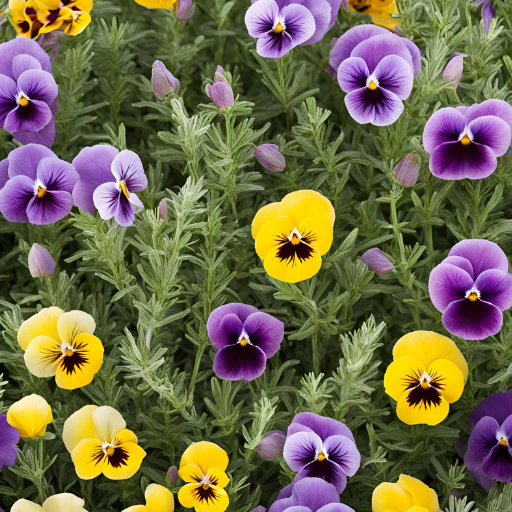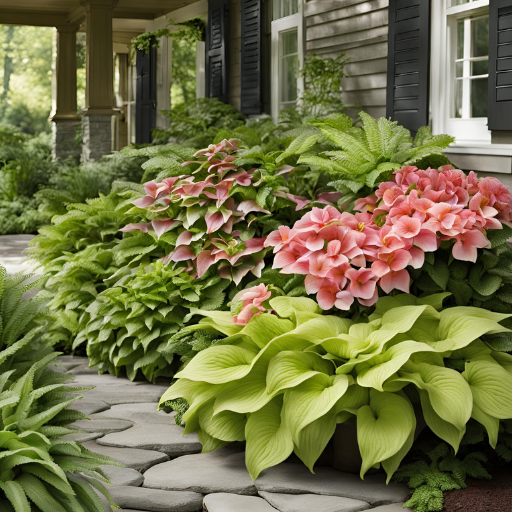Combining flowers in a container garden is a creative way to showcase your style while maximizing the beauty of a small space. By mixing different flower varieties, colors, and textures, you can create dynamic displays that draw the eye and add charm to your garden, balcony, or patio. For a visually balanced container, consider using the “thriller, filler, and spiller” approach: include a tall, eye-catching flower as the focal point, surround it with complementary medium-height plants, and let trailing blooms or vines cascade gracefully over the edges. The interplay of shapes and colors not only enhances visual appeal but also allows for a personal touch in the design, whether you prefer bold, dramatic arrangements or soft, harmonious palettes.
Choosing the right plants for your container garden involves more than aesthetics; it’s important to consider the flowers’ growth habits and care requirements. Combine flowers with similar light, water, and soil needs to ensure that all the plants in the container thrive together. For instance, pairing sun-loving petunias, marigolds, and verbena creates a vibrant, easy-to-maintain display, while shade-tolerant impatiens, ferns, and begonias offer a lush and calming effect. Seasonal considerations can also influence your choices; spring bulbs, summer annuals, or fall chrysanthemums can create a container garden that evolves beautifully throughout the year. Whether you’re aiming for a whimsical, cottage-style arrangement or a sleek, modern look, the possibilities for combining flowers in a container garden are as endless as your imagination.
1 ideas for Combining Flowers
Now that we have the basics down, let’s explore some creative combinations to get you started. Each combination is carefully curated to showcase the beauty of complementary flowers, colors, and textures. Use these as inspiration, and feel free to tweak them based on your preferences, available plants, or specific conditions in your garden.

1. Classic Elegance: Petunias, Geraniums, and Lobelia

If you’re aiming for a timeless and colorful arrangement, this trio is a fantastic option. Petunias provide lush, trumpet-shaped blooms that are available in almost every color imaginable, making them a versatile choice. Geraniums offer a more structured look with their bold, upright blooms and sturdy stems, while lobelia cascades gracefully over the edge, adding a soft, romantic touch with its delicate blue or white flowers.
Best for: Sunny locations.
Tip: Use bold-colored geraniums like red or coral to contrast with softer-colored petunias and lobelia for maximum effect.
2. Tropical Vibes: Caladium, Impatiens, and Coleus

For a tropical feel, this combination is ideal. Caladium, with its large, heart-shaped leaves splashed with white, red, and green, creates a bold backdrop. Impatiens add pops of color, thriving in shady spots, while coleus provides additional texture and color with its intricate, variegated leaves. Together, these plants create a lush, vibrant display that thrives in low-light conditions.
Best for: Shady areas.
Tip: Play with different shades of coleus to enhance the depth of color in your container.
3. Monochromatic Sophistication: White Roses, Alyssum, and Silver Dust

A monochromatic scheme exudes elegance and simplicity. White roses bring classic beauty and structure to the arrangement, while alyssum, with its dainty white flowers, fills in the gaps and adds softness. Silver Dust (also known as Dusty Miller) adds a touch of sophistication with its silvery-gray foliage, creating a lovely contrast to the white blooms.
Best for: Full sun to partial shade.
Tip: Consider adding small white flowering annuals or perennials to extend blooming throughout the season.
4. Pollinator Paradise: Lavender, Coneflowers, and Salvia

Attract bees, butterflies, and other pollinators to your garden with this fragrant, colorful combination. Lavender offers aromatic purple spikes, while coneflowers (Echinacea) provide a bold focal point with their large, daisy-like flowers. Salvia rounds out the combination with its spiky blue or purple flowers, creating vertical interest and adding to the pollinator appeal.
Best for: Full sun.
Tip: Mix different shades of lavender and salvia for added visual interest.
5. Dramatic Foliage: Elephant Ear, Heuchera, and Sweet Potato Vine

For those who love a foliage-focused display, this combination offers a bold, dramatic statement. Elephant Ear’s large, tropical-looking leaves create a stunning centerpiece, while Heuchera adds color with its rich, burgundy, or lime-green leaves. Sweet Potato Vine trails beautifully over the edge, adding texture and contrast with its vibrant, chartreuse, or deep purple foliage.
Best for: Partial shade.
Tip: Be mindful of container size—elephant ear needs ample space for its large leaves.
6. Pastel Perfection: Hydrangeas, Begonias, and Dusty Miller

For a soft, romantic look, pastel-colored flowers are a go-to choice. Hydrangeas, with their large, ball-like clusters of flowers in shades of pink, blue, or white, create a beautiful focal point. Begonias add complementary blooms with their soft pink or peach tones, while Dusty Miller provides contrasting silvery foliage for a touch of sophistication.
Best for: Partial shade.
Tip: Keep hydrangeas well-watered and use containers large enough to accommodate their root systems.
7. Sunny Yellow Burst: Marigolds, Sunflowers, and Coreopsis

If you’re looking for something bright and cheerful, yellow flowers are perfect. Marigolds, with their sturdy, compact growth and abundant blooms, pair beautifully with towering sunflowers for height and drama. Coreopsis adds a lighter, airy texture with its delicate, daisy-like flowers, creating a cohesive and energetic display.
Best for: Full sun.
Tip: Consider dwarf sunflower varieties for containers, as they won’t overwhelm the other plants.
8. Cool Tones: Blue Delphiniums, White Petunias, and Dusty Miller

Cool tones can create a calming, serene atmosphere in your garden. Blue delphiniums add height and elegance with their tall, spiky blooms, while white petunias provide a soft, neutral base. Dusty Miller’s silvery foliage ties the combination together, adding contrast and sophistication.
Best for: Full sun.
Tip: Add blue and white pansies or lobelia for additional color and texture at the base.
9. Herb & Flower Combo: Lavender, Rosemary, and Pansies

This combination is both beautiful and functional, offering lovely flowers and fragrant, edible herbs. Lavender brings soothing fragrance and delicate purple blooms, while rosemary offers an evergreen element with its needle-like foliage. Pansies add cheerful color in a variety of hues and are a lovely complement to the herbs.
Best for: Full sun.
Tip: Harvest herbs regularly to promote new growth and prevent them from overtaking the flowers.
10. Low Maintenance Mix: Succulents, Sedum, and Portulaca

For those seeking a low-maintenance option, succulents, sedum, and portulaca are excellent choices. Succulents provide architectural interest with their unique shapes and textures, while sedum offers a variety of colors and forms. Portulaca, also known as moss rose, adds vibrant, daisy-like blooms that thrive in hot, dry conditions.
Best for: Full sun.
Tip: Use a well-draining soil mix specifically designed for succulents and avoid overwatering.
11. Shade-Loving Beauty: Ferns, Hostas, and Begonias

Not all container gardens need full sun to thrive. For shady spots, this combination offers lush, green foliage with pops of color. Ferns add soft, feathery texture, while hostas provide bold, variegated leaves. Begonias add bright blooms in shades of red, pink, or white, making this a beautiful choice for low-light areas.
Best for: Shade or partial shade.
Tip: Keep the soil consistently moist, but ensure the container has good drainage to prevent waterlogging.
Section 3: Tips for Success
Combining flowers in a container garden takes some planning and care to ensure success. Here are a few essential tips to keep your garden healthy and thriving.
Watering and Fertilizing
Containers dry out much faster than garden beds, especially in hot weather, so consistent watering is crucial. Most container gardens will need daily watering, particularly in full sun. Use a slow-release fertilizer or feed your plants with liquid fertilizer every few weeks to provide the necessary nutrients for growth and flowering.
Proper Drainage
Good drainage is essential in container gardening to prevent root rot. Make sure your containers have drainage holes and use well-draining soil. Adding a layer of gravel or small rocks at the bottom can also help improve drainage.
Deadheading and Maintenance
Regular maintenance will keep your container garden looking fresh and healthy. Remove spent blooms (deadheading) to encourage new growth and prevent your plants from focusing energy on seed production. Trim back overgrown plants and replace any that start to decline.
Conclusion
Container gardening offers endless possibilities for creativity and expression. Whether you’re combining flowers for bold color, texture, fragrance, or pollinator appeal, the ideas shared here will help you design stunning arrangements that brighten any space. Remember to consider your plants’ needs for sun, water, and space, and don’t be afraid to experiment with different combinations to find what works best for you.
So, grab a few pots, head to the garden center, and start planting! The beauty of container gardening lies in its versatility—you can mix and match plants, change things up from season to season, and adapt your garden to your taste and conditions. Enjoy the process, and happy gardening

